Mushrooms are strange and wonderful fungi. Most of us find them simply fascinating. And did you know that there are mushrooms that look like flowers?
Some mushrooms have a very striking resemblance to flowers. The most notable of these are the fly agaric and the death cap. Both of these mushrooms have a vibrant red color with white spots. In this article we’ll include other fungus that fit this category. If you are looking into adding your knowledge on wild mushrooms, keep reading.
List of Most Beautiful Mushrooms that look like flowers
It is important to be cautious when identifying and consuming wild mushrooms, as some species can be poisonous. If you are unsure whether a mushroom is safe to eat, it is best to err on the side of caution and not consume it.
1. Golden trumpet mushrooms
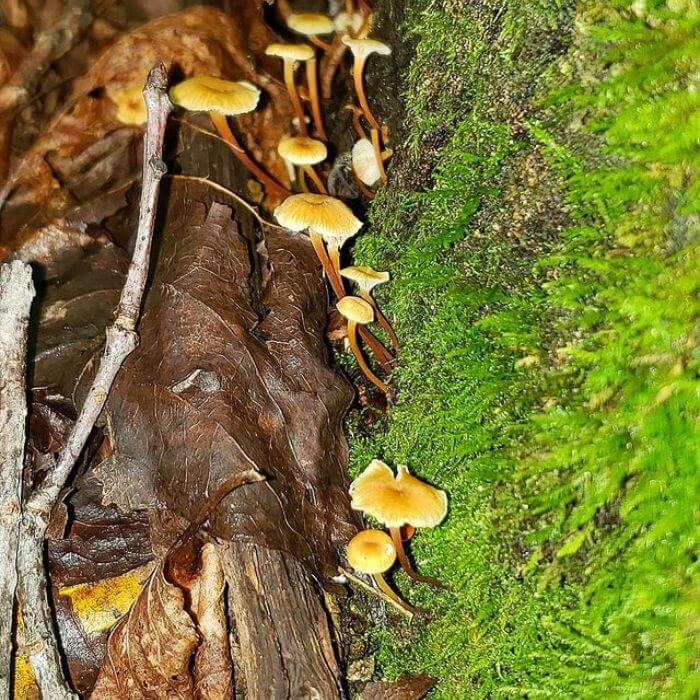
source: adam_bushlow
Golden trumpet mushrooms are one of the most popular mushrooms in the world. They are native to North America during wet seasons.
Identify mushrooms
Their fruiting body consists of a convex-shaped 0.5-0.8 inches wide cap and a 2-inch stalk when fully mature. On the underside, you’ll notice a well-spaced yellow-orange gill. The stalk is reddish-brown. This vibrant color combination makes them easy to spot.
Also, golden trumpet mushrooms grow in tight clusters. Are they edible? Yes, this wild mushroom is edible but the bitter taste will definitely put you off. When mushroom hunting, you can find them around decaying conifer trees.
2. Orange peel fungus
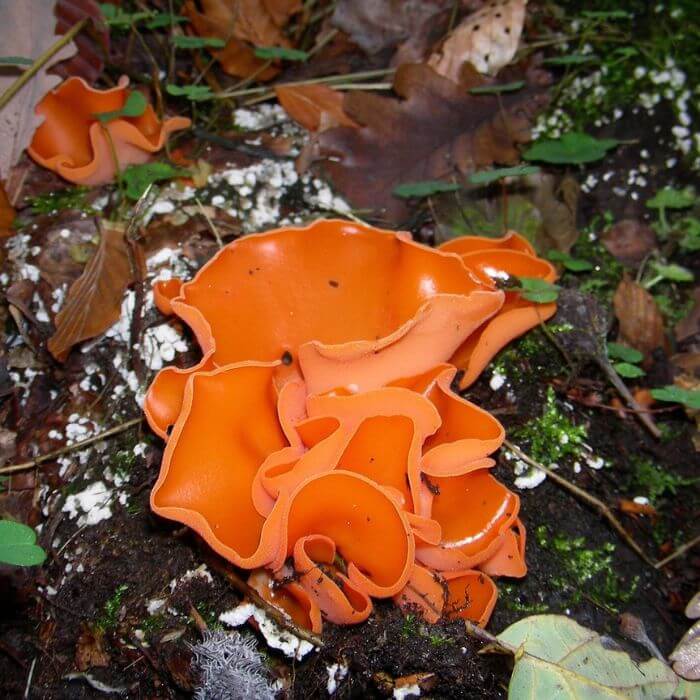
Orange peel mushrooms are one of the most beautiful mushrooms that look like flowers. These pretty mushrooms are also known as Aleuria aurantia, they are a type of edible mushroom that resemble flowers.
Identify mushrooms
The mushrooms are characterized by their orange-colored caps that resemble orange peels, giving them their name. The cup-shaped cap measures about 4 inches for mature mushrooms. When torn or cut, it reveals pale-colored flesh.
This cup shaped mushroom is found in areas with clay soil, from late summer to autumn. Orange peel fungi are regarded as edible mushrooms.
3. Pink Oyster Mushroom
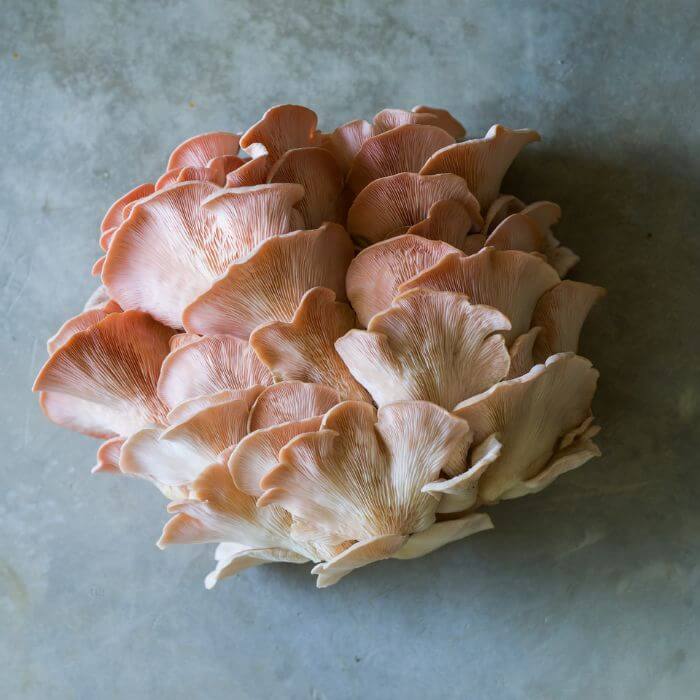
I think pink oyster mushrooms are some of the most beautiful mushrooms around and here is why.
Identification:
Pink oyster mushrooms are native to North America and Europe, and they get their name from their pinkish-red color. These mushrooms thrive in warm climates and prefer to grow on dead or dying trees.
Their oyster-shape caps start out with deep pink coloring and turn whitish as the mushrooms age. And like the golden trumpets above, they grow in clusters. Are they edible?
Pink oyster mushrooms are not only pretty to look at, but they’re also edible! In fact, these mushrooms have a slightly sweet taste and can be used in many different dishes. So if you’re looking for something new to add to your cooking repertoire, why not give pink oyster mushrooms a try?
If you are adventurous, you can go foraging for them from April through September.
4. Pepper Pot (Myriostoma coliforme)
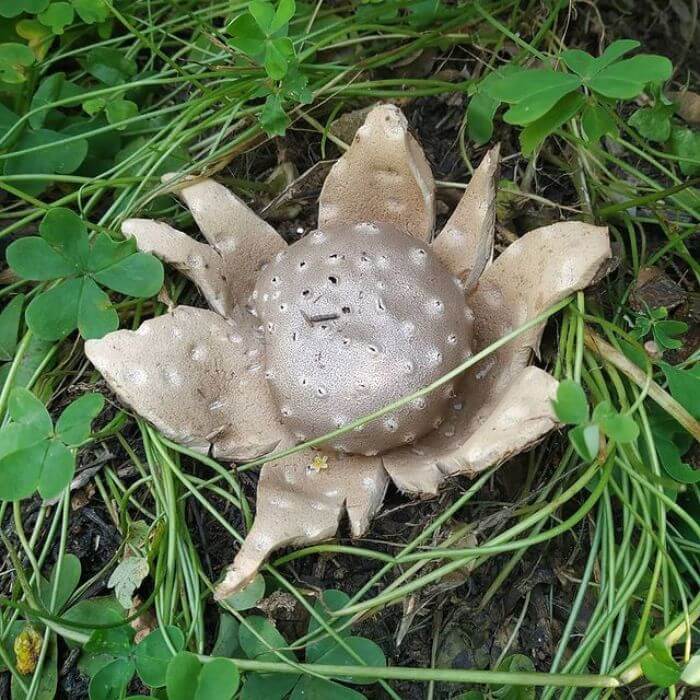
source: aguacates_ecocaminos
Found in gardens as well as mixed forests, pepper pots are unique mushrooms that look like flowers.
Identification:
The fruiting body is quite unique. It starts growing underground and slowly pushes itself above ground.
As the mushroom matures, the outer skin peels open, revealing a ball-shaped fruiting body. Younger fruiting bodies are yellow and turn brown as they age. They are inedible.
5. Stalked Scarlet Cup
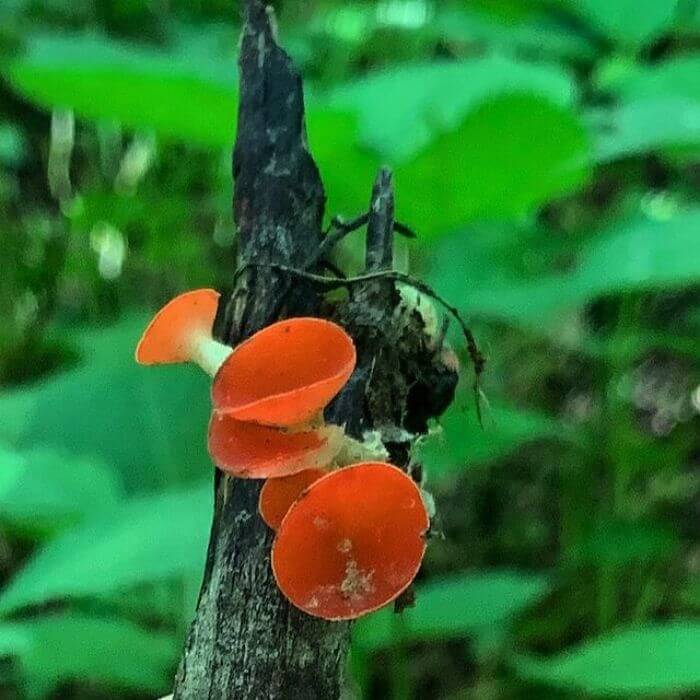
source: sweetpea87
The Stalked Scarlet Cup Mushroom, is a small, delicate mushroom that has a beautiful scarlet color.
Identification:
These cute mushrooms come with small 0.8 inch caps that are slightly curved inwards. The stipe is about 1.2 inches and is pale colored.
This type of mushroom is often found in wooded areas, and it is said that they are one of the cool mushrooms that can survive in the shade. The Stalked Scarlet Cup Mushroom gets its name from the stalk that supports the cup-shaped cap. This mushroom is inedible.
6. Violet Coral Fungus
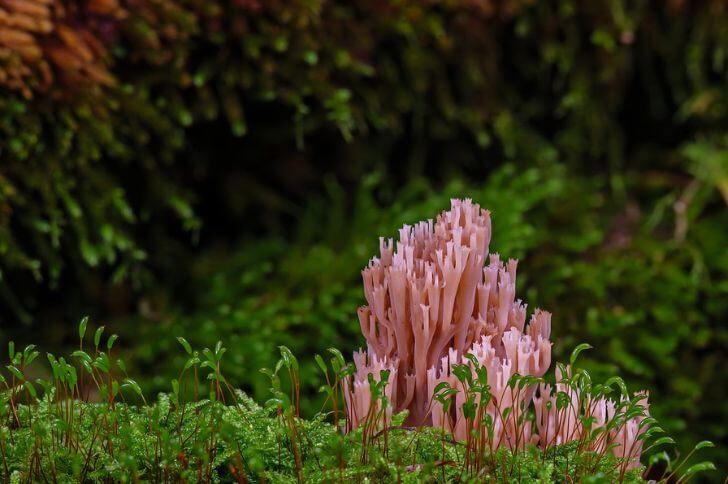
Violet coral fungus is a type of fungi that gets its name from its color and shape.
Identification:
The fruiting body ranges from 1.6-2.8 inches wide and 2-3.9 inches tall. Also, their color ranges from amethyst to a gorgeous violet or violet with hints of brown or red.
The fungus is found in wooded areas and feeds on dead or decaying wood. It is a parasitic fungus, meaning it needs another organism to live. In this case, the violet coral fungus needs a tree to host it.
The violet coral fungus is not harmful to humans and is actually quite beautiful. However, it can be deadly to trees. If you see this fungus in your yard, it’s best to remove it as soon as possible.
7. Fragile Dapperling
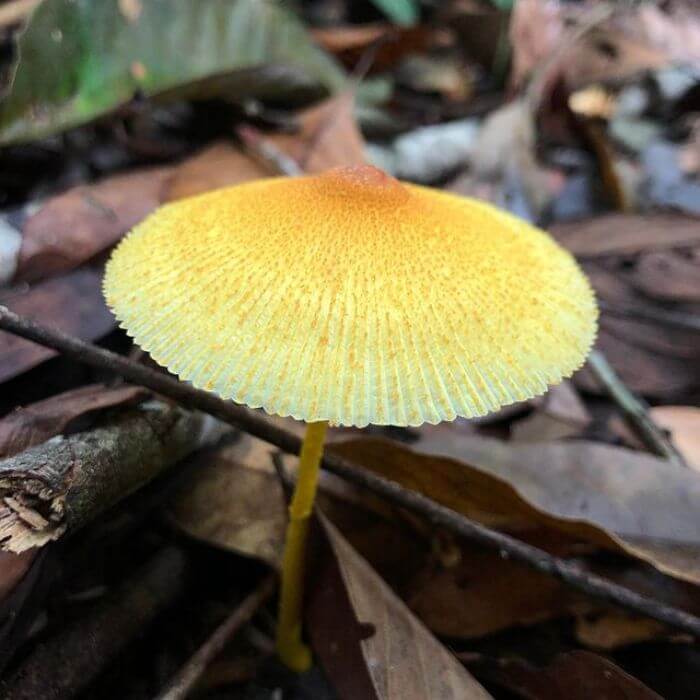
source: chacaracosmea
One of the most beautiful wood mushrooms is the fragile dapperling. They are common in the South United States, mostly on decaying organic matter.
Identification:
The fragile dapperling mushroom is a small, delicate fungi that is typically white or yellowish colored with an almost flat cap. The paper-thin cap has a yellow-green center. On its underside you’ll notice widely spaced gills.
8. Hydnellum peckii (Devil’s Tooth)
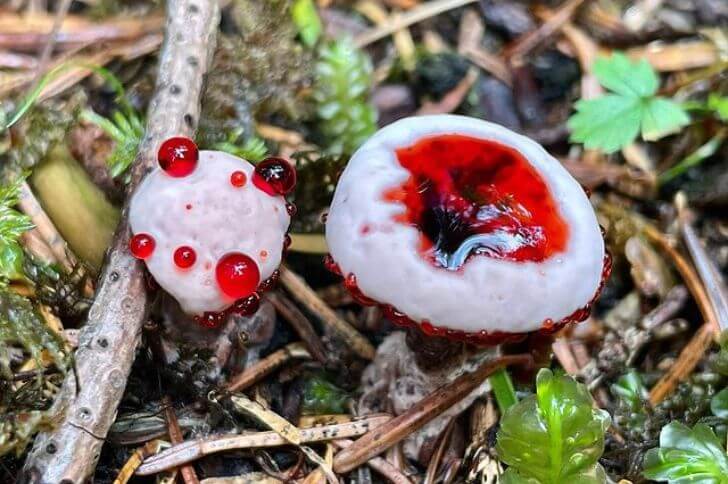
source: umberto_zanghi
Now to what I think is the most interesting mushroom on this list, the hydnellum peckii. You may know them by another name; Devil’s tooth, strawberries and cream, or bleeding tooth fungus. If you’ve never come across this species, this is what to keep an eye for.
Identification:
Hydnellum peckii is a species of tooth fungus in the family Bankeraceae. It is found in North America, where it grows on the wood of conifers. The fruit body of the fungus is a white to pale pinkish-buff cup with a toothed margin.
The surface of the cup is covered with small spines. The spores are brownish. Also the pores on the surface produce a red juice, giving them their look and name.
These mushrooms that look like flowers are edible but honestly not worth it.
9. Fly Amanita
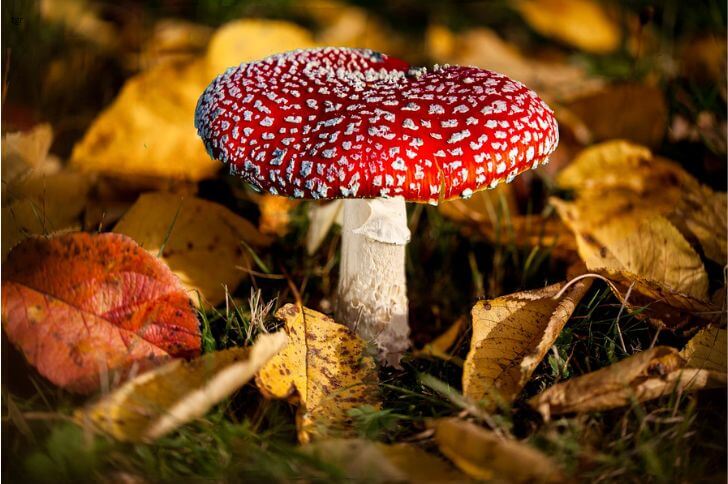
Striking and unmistakable, the Fly Amanita or fly agaric or amanita muscaria are a family of pretty fungi that are common in North America, Europe and Asia.
Identification:
Very distinctive features that’ll help you identify them at first sight. Fly Amanita grows in damp, shady areas such as woods and meadows, and can be found throughout the spring and summer months.
The red mushroom has a distinctive red cap with white spots, and is considered to be one of the most beautiful mushrooms in the world. They are not edible, but if you are looking for a mushroom from their family that is edible, check out the Amanita Caesar in this comprehensive list of wild mushrooms.
10. Pink Bonnet
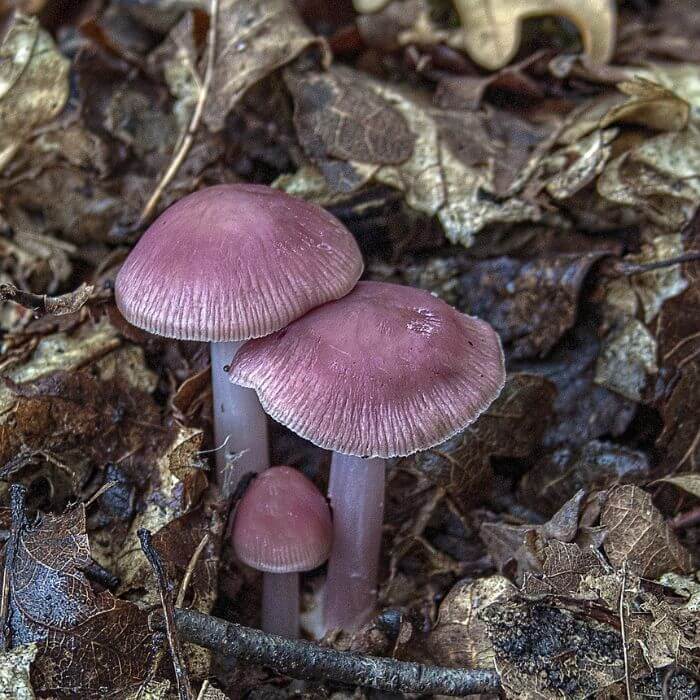
The pink bonnet mushroom is an inedible beautiful fungi that occurs in broadleaf woodlands.
Identification:
These mushrooms have a distinctively pink cap. The pink color is due to the presence of carotenoids, which are pigment molecules that absorb light.
While the caps of these mushrooms can vary in size, they typically measure 2.4 inches diameter. The stalks of pink bonnet mushrooms are usually pale pink and hollow.
11. Collybia cirrhata
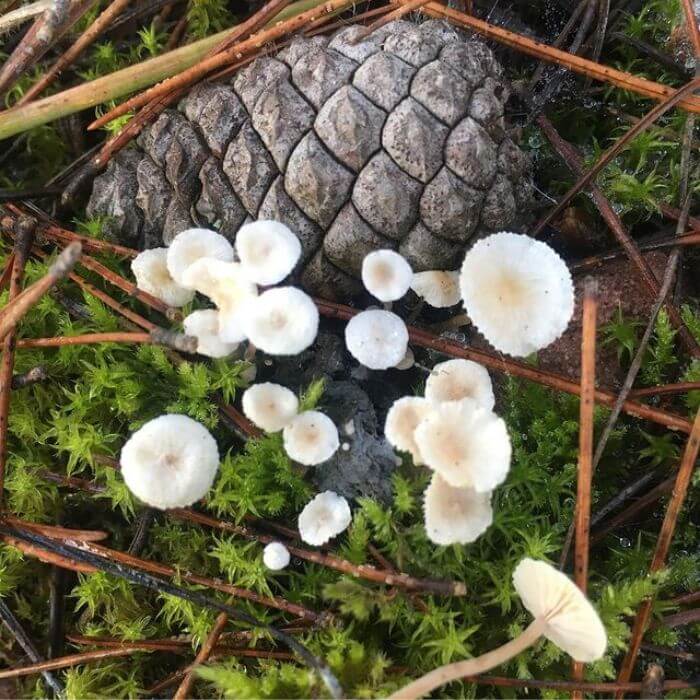
source: ribapellise
Collybia cirrhata is a species of gilled mushrooms that was first described in 1786. They are easy to identify.
Identification:
The fruit bodies are small caps with white gills that grow on decaying wood. Young mushrooms have convex-shaped caps. Notice the inrolled margins. As they mature, the cap flattens. Their flesh is thin and whitish.
This little brown mushroom may not look like much, but it plays an important role in the forest ecosystem. As a decomposer, Collybia cirrhata helps to break down dead trees and other organic matter, making nutrients available for other plants and animals. This process is essential for the health of the forest.
12. Elegant Stinkhorn
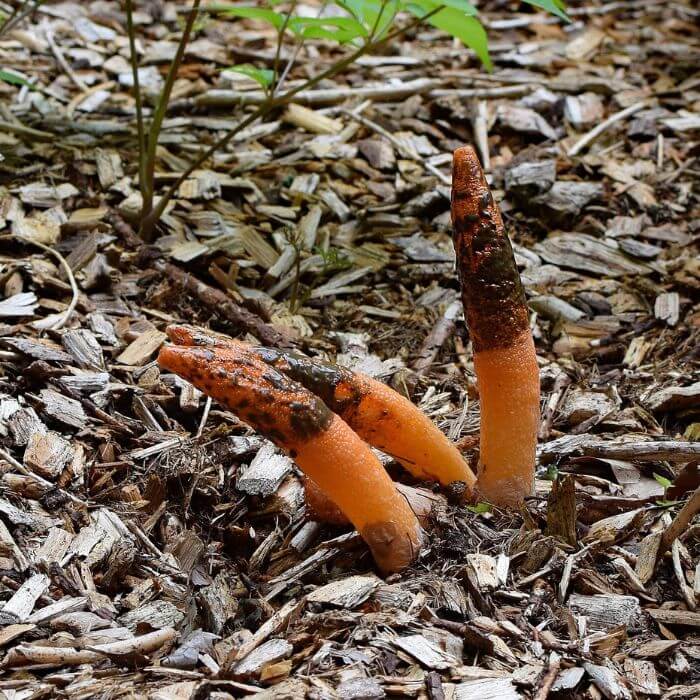
The Elegant Stinkhorn is a fungi that releases spores to disperse its seeds. They are common in Texas and Colorado.
Identification:
The spore-bearing structure of the Elegant Stinkhorn looks like an egg when it first emerges from the ground.
The “egg” then breaks open, revealing a long, reddish-orange stalk that is hollow with a dark, spore-bearing tip. The Elegant Stinkhorn gets its name from the foul smell it emits when the spores are mature and ready to be released.
13. Sky Blue Mushrooms
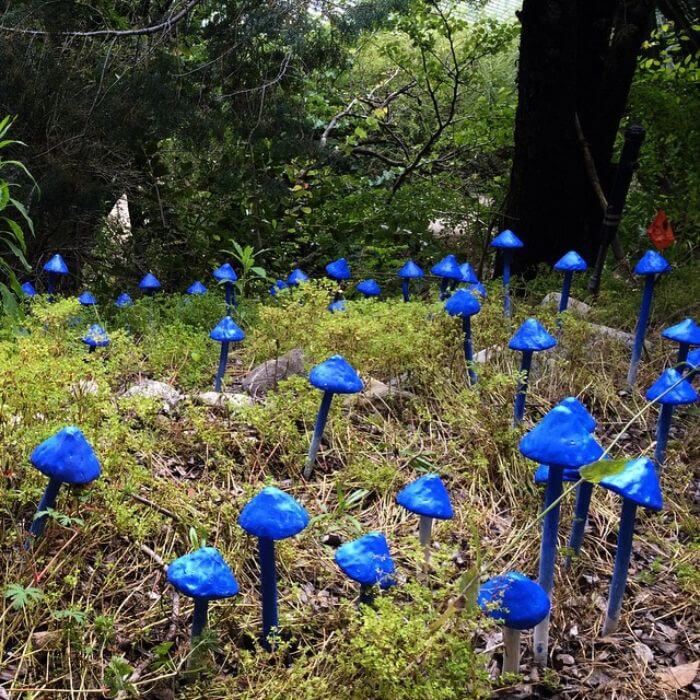
source: cass_jonez
Sky blue mushrooms are a type of fungi that gets its name from its bright blue color. These mushrooms can be found growing on trees, logs, or the ground in wooded areas.
Identification:
Named after their color, sky blue mushrooms are easily the most distinctive mushrooms that look like flowers. They sport an umbrella-shaped cap that is about 1.2 inches in diameter. The underside has thin gills.
These mushrooms get their color from a pigment called azulene, which is also found in other blue flowers like forget-me-nots.
The pigment is what gives sky blue mushrooms their distinctive color. When the mushroom is young, the cap is often a deep blue color. As the mushroom matures, the cap becomes more pale.
Despite their beautiful color, sky blue mushrooms are not considered to be good luck in many cultures. In fact, some believe that these mushrooms bring bad luck and misfortune to those who find them.
14. Hericium Coralloides (Coral tooth fungus)
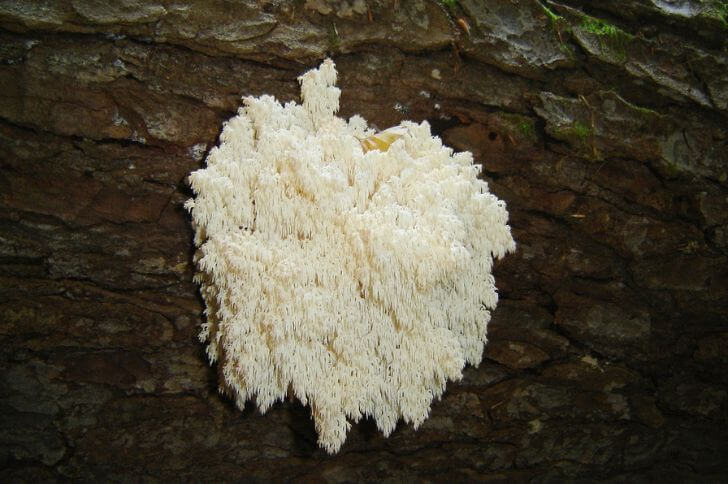
Hericium coralloides is a fungus that belongs to the tooth fungi group. It is commonly known as the coral tooth. This fungus is common.
Identification:
Hericium coralloides grow on dead or dying hardwood trees. The fruit bodies are large and have a white or cream-colored exterior with a “toothed” surface. The interior of the fruit body is hollow and contains numerous small, brown spores.
This fungus is edible but honestly I would recommend you opt for tastier mushrooms like chanterelles.
15. Rosy Veincap
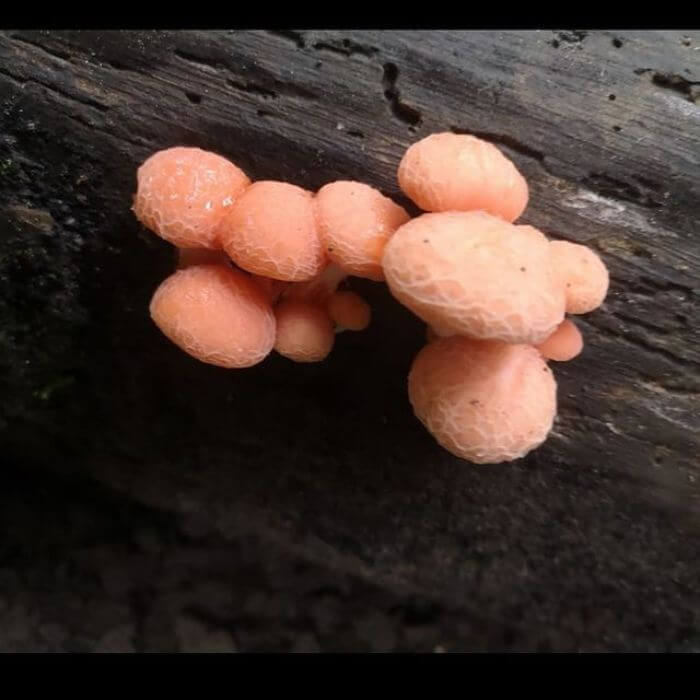
source: aman.eater
Rosy Veincap is a beautiful, inedible mushroom that occurs in North America as well as Europe. It is a one-of-a-kind mushroom, making identification easy.
Identification:
Also known as the wrinkled peach or rosy veincap, this delicate fungi has a veined pink cap. Young mushrooms are more veined, giving it a gorgeous net-like appearance. As they age, the cap will flatten and the veins fall off, giving it a smooth appearance.
Its gills are also pinkish and do not touch the stem. The stem itself is usually no more than two inches tall. You can spot them around decaying elm trees.
16. Velvet Shank
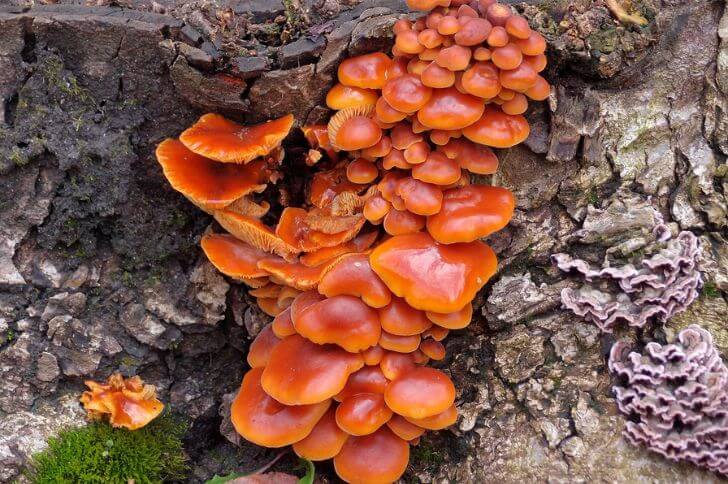
Velvet shank mushrooms are a type of fungi that grows on tree barks. They are native to North America and much of Europe.
Identification:
Velvet shanks grow in large clusters. The mushrooms are orangish-brown when young and brown when mature. The cap is shiny when dry and slimy in wet months. Note the slightly convex shape.
Gills are widely spaced while the stalk is long and the same color as the cap. Velvet shank mushrooms are edible and are mostly found in December through January.
They can be used in soups or stews to add flavor, but are not typically eaten on their own. The mushroom is native to Europe and Asia, and has been introduced to North America.
17. Veiled Lady Mushroom
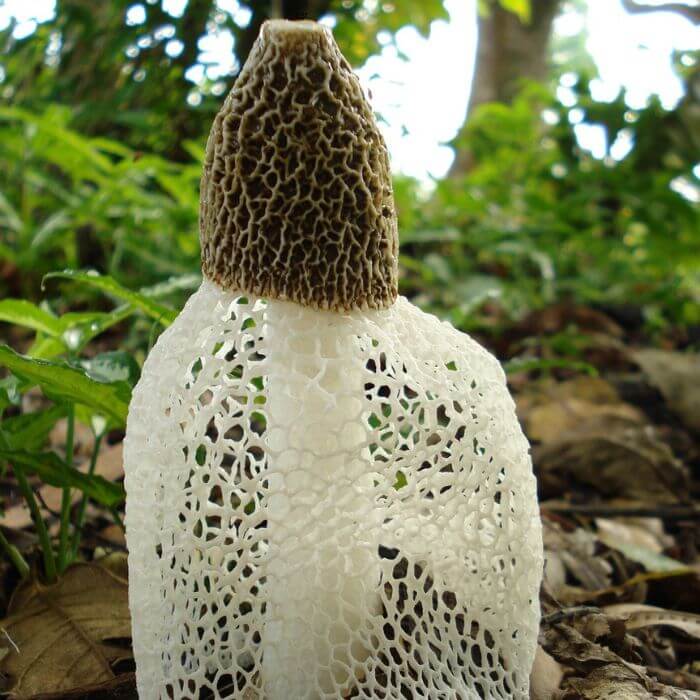
The Veiled Lady Mushroom is a unique and beautiful mushroom that is found in the forests of North America. You may know it as bamboo pith, bamboo mushrooms, crinoline stinkhorn, or long net stinkhorn.
Identification:
This mushroom has a cap that looks like morel mushrooms fruiting body. The stem of this mushroom is white and is typically 4-6 inches tall. The stalk is covered by a white net-like veil.
This mushroom gets its name from its outer structure resembling a lady’s veil. The Veiled Lady Mushroom is edible and has a mild flavor. This mushroom can be found growing on decaying logs or on the ground in moist forested areas. But it is also widely cultivated.
18. Laccaria Amethystina
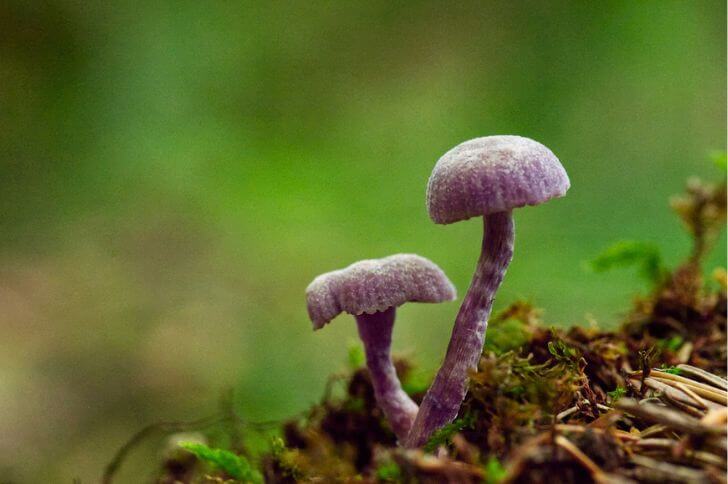
Pretty and unmistakable, the Laccaria amethystina, also known as the Amethyst Deceiver, is a small mushroom that is native to North America.
Identification:
This deceptively beautiful mushroom is often found in forests in leaf litter. Although it is fairly common, it is not often seen due to its small size.
The Laccaria amethystina gets its name from its amethyst coloration. The caps and stems of this mushroom are both a deep purple hue.
The Amethyst Deceiver is an edible mushroom, but it is not considered to be very good eating. It has a mild flavor and a slightly spongy texture.
This mushroom can be cooked and used in soups or stews, but it is not typically eaten on its own.
Final Thoughts on Mushrooms that look like flowers
In conclusion,mushrooms are a fascinating and beautiful part of nature. Though they are often feared or misunderstood, they play an important role in many ecosystems. With a little knowledge and understanding, mushrooms can be enjoyed by everyone.
Sources:
Hi There,
My name is Jenny. I’m the Chief Editor at Try Green Recipes and besides making yummy and healthy foods for my kids, grandkids, and friends. I’m new to the blogging world but I believe what I have to share is unique and will bring joy to your home. If you are adventurous and want try something tasty, let’s get started.

